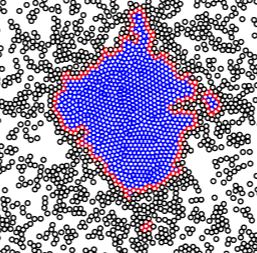MetaSimulation of NonEquilibrium Processes
The MSNEP Group
MetaSimulation of NonEquilibrium Processes
Self-Organization in Biomimetic Active Matter

Living systems have the unique ability to form hierarchical assemblies, in which individual constituents can perform tasks cooperatively and emergently. Harnessing such properties is a long-standing challenge for the rational design of dynamic materials, that can respond to their environment, communicate with one another, and undergo a rapid, reversible, assembly through the transduction of energy. Recent developments in the design of smart and active colloidal building blocks have led to tremendous breakthroughs, with, for instance, the onset of synthetic photoactivated active assemblies known as “living crystals” that can form, break, explode and re-form elsewhere. In this work, we develop a combined experimental, computational, theoretical and Machine Learning framework to shed light on the physical underpinnings of such assembly processes and program the assembly of smart active materials.
Work funded by DOE through award DE-SC0023673.
Collaborators: Paul Chaikin (NYU), Stefano Sacanna (NYU) and Mark Tuckerman (NYU).
ML and AI for assembly in molecular crystals

Molecular crystals play an essential role in the pharmaceutical, agrochemical, electronics, and defense industries. In many instances, a given chemical compound may have more than one crystal structure, a phenomenon known as polymorphism. A crystal may also contain impurities, the most important among these being water. Such structures are referred to as crystal hydrates. The ability of these materials to function in a desired manner may depend on which structure, pure or impure, they form. Utilizing advances in high-performance computing and artificial intelligence, we create new computational approaches and software components for rapidly predicting polymorphic structures in molecular crystals and understanding the transitions between structures.
This research is funded by NSF through CHE-2240526.
Collaborator: Mark Tuckerman (NYU).
Nonequilibrium processes in electrochemical devices
Understanding and optimizing solid-solid interfaces in graphene-based nanocomposite catalysts is crucial for electrocatalytic applications such as CO2 reduction. Molecular functionalization of graphene offers enormous opportunities to prepare new electrocatalysts with enhanced electron transfer kinetics. Here we develop a new strategy for constructing innovative electrocatalysts from metal nanoclusters covalently attached onto three-dimensional pristine graphene electrodes through rationally designed molecular linkers. Using a combination of synthesis, computational modeling, electrochemistry, and spectroscopy, we shed light on how the control over solid-solid interfaces at the molecular level impacts the performance of nanocomposite materials in electrochemical devices.
Work funded by NSF through award CHE-2247574.
Collaborators: Kwok-Fan Chow (UML), Mingdi Yan (UML), and Gonghu Li (UNH).
Nonequilibrium phenomena in quantum computing
Quantum materials exhibit exotic properties and thus lead to new phenomena and functionalities not expected from classical physics. Here, we propose a combined deep-learning theoretical physics approach to find innovative solutions for next-generation quantum technologies. In this project, we formulate novel theoretical frameworks and develop new physics-informed machine learning and artificial intelligence algorithms to manipulate and harness quantum states for computation, sensing, and communications.
Work funded by the Peter E. and Anna Giants KCS Endowed Fund for Advanced Research.
Collaborators: Caroline Desgranges (UML) and Hugo Ribeiro (UML).